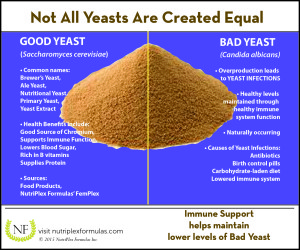Many concerned women have looked at the ingredient list on a food or supplement label and replaced the product on the shelf after seeing the word “yeast.” After all, no one wants a yeast infection. Contrary to  popular belief, though, consuming yeast doesn’t contribute to the growth of vaginal yeast. End of story.
popular belief, though, consuming yeast doesn’t contribute to the growth of vaginal yeast. End of story.
The Yeast Down There
The vagina contains a small amount of Candida albicans, one type of yeast, at all times. It’s when too many yeast cells are present that a “yeast infection” occurs.
The bacteria Lactobacillus acidophilus is responsible for keeping yeast numbers in check, which means it has to exist in adequate supply within the vagina. If a change in the body occurs to alter the amount of Lactobacillus acidophilus or Candida albicans present, the Candida albicans will flourish, resulting in any number of symptoms, including vaginal itching and soreness, pain or burning with urination or sex, and thick discharge.
The balance of both bacteria and vaginal yeast levels is delicate and can easily be thrown off, which is why yeast infections are fairly common. That said, neither level is affected by the consumption of food yeast.
To keep the balance, it’s important to know what leads to a depletion of Lactobacillus acidophilus (good bacteria), as well as what enables the overproduction of Candida albicans (vaginal yeast):
Both a lowered immune system and antibiotics often lead to the death of good bacteria, including Lactobacillus acidophilus, even when antibiotics are only meant to dispel the unwanted variety.
Heightened estrogen levels also increase the number of Candida albicans cells in the vagina. Sugar does the same thing: The higher a female’s sugar intake, the more yeast cells are able to grow.
As delicate a balance as it is, it’s not too hard to achieve and can be done through maintenance of a good diet and healthy immune system. A healthy immune system translates into high levels of healthy bacteria and low levels of yeast.
In the pursuit of a healthy immune system, follow these three basic rules:
- Avoid toxins, as much as possible (such as chemicals, pesticides, and fumes from foods, the environment and personal care products)
- Avoid sugar in all its forms
- Take Immune Support, by NutriPlex Formulas
Food Yeast
They may bear the same common name (yeast), but the yeast that’s considered safe for human consumption is completely different from that which is present in the vagina. As it is commonly a source of confusion, it’s perhaps more helpful to think of food yeast – also referred to as Brewer’s Yeast, Budding Yeast, Nutritional Yeast, Yeast Extract, and other names – by its scientific name: Saccharamyces cerevisiae. [There are other types of edible yeasts, but Saccharamyces cerevisiae is the most commonly used.]
Not only have scientists proven that Saccharomyces cerevisiae DOES NOT contribute to a yeast infection, but it is often hailed for its many health benefits, such as serving as a terrific food source of chromium, protein, and B vitamins; lowering blood-sugar levels; battling cancer; improving the immune system; and more. For this reason, it’s used in a number of nutritional supplements, such as in NutriPlex Formulas’ female-support supplement, FemPlex.
The moral of the story is that not all yeasts are created equal, and the less desirable yeast is not proliferated by consuming the beneficial kind. To avoid yeast infections, concentrate on living a healthy lifestyle, limiting sugar intake, and taking Immune Support.
Sources:
http://healthyeating.sfgate.com/health-benefits-brewers-yeast-5425.html
http://www.webmd.com/women/tc/vaginal-yeast-infections-topic-overview

